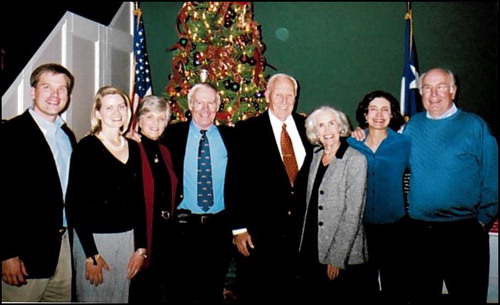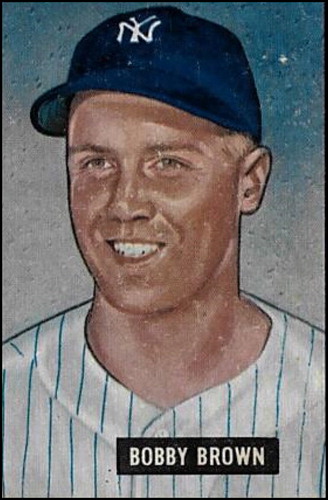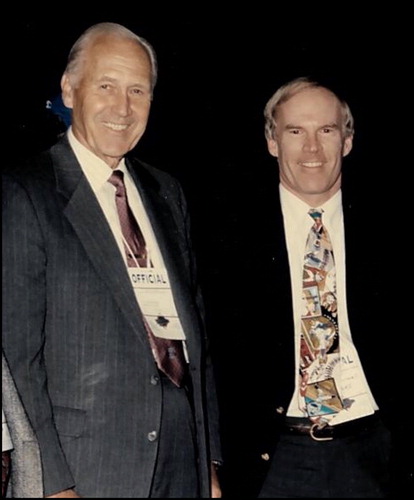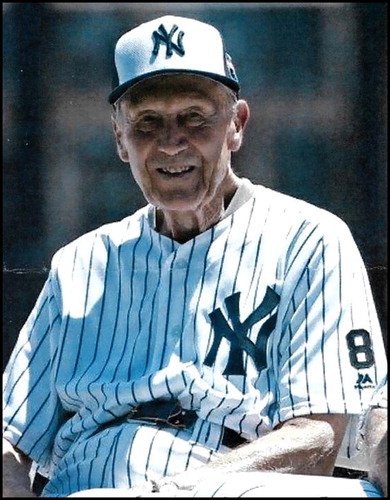As a young boy growing up in a small town in mideastern Wisconsin, I aspired to become a Major League Baseball player and a physician. My role model was Bobby Brown—Dr. Bobby Brown—who worked his way through medical school by playing third base for the New York Yankees.Citation 1
Bobby once attended a baseball tryout. His father was seated in the stands, near some baseball scouts. Mr. Brown walked over to a scout and asked him what he thought of the youngster at bat. “He has a nice swing,” he was told, “but doesn’t have much power for an 18-year-old.” “That’s because he’s only 13,” was the father’s reply.Citation 2
Bobby made his debut with the 1946 Yankees (), splitting time with Billy Johnson. Larry MacPhail, a Yankee owner, had extolled the talents of his bonus baby—a fine young man who didn’t smoke, drink alcohol, or chase girls—noting “what a brilliant young doctor he was going to become.” A reporter finally asked, “Larry, are you signing him as a player or a doctor?”Citation 3 Veteran pitcher Joe Page promptly nicknamed rookie Brown “Quack,” to keep him humble.
Another Yankee veteran, Tommy Henrich, was dubbed “Old Reliable” for his ability to do well in crucial situations. Henrich recognized the same trait in Brown: “For a million dollars in a tough situation, … he will not choke. He might cut down on his swing a little, he might protect the plate a little more carefully but he would also become more determined.”Citation 3 This observation was confirmed by Brown’s career batting average of .439 in World Series competition.
My baseball playing career never got off the ground. At age 18, I was invited to a tryout in Milwaukee County Stadium by the defending World Champion Milwaukee Braves, only to be told by their Hall-of-Fame batting coach Paul (“Big Poison”) Waner that I didn’t move my belly button fast enough to become a Major League hitter. I did go on to medical school and, like Dr. Brown, became a cardiologist. I was fortunate to also become a team physician for the Atlanta Braves for 41 seasons, until 2017.
In the 1980s, while attending the winter baseball meetings in Louisville, I finally got to meet Bobby Brown. Then the president of the American League (), he kindly regaled me with stories of his roommate, Yogi Berra, and other teammates. A writer once contrasted the odd couple who roomed together: “Bobby Brown is tall, handsome, debonair, brilliant, polished and educated. Yogi Berra is none of these things.”Citation 1 Footnote a Bobby was the first to hear several “Yogi-isms.” They would read in bed, Brown studying his medical texts and Yogi his favorite comic books. Before turning the lights off, Yogi exclaimed that he really enjoyed his story and asked Bobby how his turned out.
Yogi was a free swinger at the plate, sometimes going after pitches over his head or off the tips of his shoes. Yankee coaches gave him a lot of things to work on. Once, after a frustrating at-bat, Yogi returned to the bench and told Bobby, “I can’t think and hit at the same time.” Blessed with wonderful hand-eye coordination, he just needed to rely on that special talent. He rarely struck out, only 12 times in the 1950 season.
In Dallas–Fort Worth, for another winter baseball meeting, Dr. Brown invited my wife, Marilyn, and me along with our physician son, Ryan (also a Braves team doctor) and his wife, Tina, and close friends Paul and Julie Rogers to dinner at his country club (). Bobby told me that before meeting the parents of his future wife, Sara, he said for her to tell her dad he was a ball player and to tell her mother that he was in medical school.
Figure 3. Our group at the Browns’ country club. Left to right: Ryan and Tina Cantwell, Marilyn and John Cantwell, Bobby and Sara Brown, Julie and Paul Rogers.

Marilyn asked him if he had had any unusual experiences as both a cardiologist and a professional baseball player. Bobby related an instance when he was called in one evening to evaluate a patient who was in a two-bed room, separated by a curtain. Midway during his examination, Dr. Brown noted the TV was replaying an old Yankee game due to a rain delay. The opposing pitcher was intentionally walking Joe DiMaggio to load the bases and to face the young third baseman. “Watch,” Dr. Brown told the patient, “I’ll bet he hits the next pitch off the wall and scores all three runs,” which the batter promptly did. Suddenly the curtain separating the patients flew open and the man in the adjacent bed said, “How did you know he was going to do that?” “Just a lucky guess,” the modest Dr. Brown said with a smile, not revealing that he was the batter.
Speaking of DiMaggio, Bobby was stationed in Japan during the Korean War era when Joe married Marilyn Monroe. Joe was advised by another teammate to honeymoon in Japan, where they wouldn’t be bothered. The newlyweds landed at the airport and were to meet Brown at their hotel shortly thereafter. Hours later the newlyweds finally arrived. Word had gotten out and thousands had lined up to greet them all along their route. DiMaggio’s advisor had apparently forgotten that the Japanese revere movie stars and baseball players.
Late in life, Dr. Brown survived two serious medical events, a thoracic aortic artery dissection and a high cervical spine injury after a fall. Fortunately, the latter did not result in quadriplegia.
Now in his mid 90s, Bobby Brown is the second oldest living ex-Yankee (), recently honored at a Yankee “Old Timers” game. He lost his lovely wife, Sara, in 2012, after over 60 years together, and lives close to his three children, 10 grandchildren, and four great-grandchildren in Fort Worth.
Acknowledgments
My thanks to Stacie Waddell for her help with the figures and to Fred Boyer for preparing the manuscript.
Notes
a Despite the initial perceived deficiencies, Yogi would become one of the most successful and beloved players in baseball history.
- Cantwell JD. Encounter with a boyhood role model. Am J Cardiol . 1996;77(4):327–328. doi:10.1016/s0002-9149(97)89414-3.
- Roberts WC , Brown RW. Robert William (“Bobby”) Brown, MD, cardiologist, Major League Baseball player (New York Yankee) and American League president: a conversation with the editor. Am J Cardiol. 2007;5:715–742.
- Halberstan D. Summer of 49 . New York: Harper Collins; 1989.



